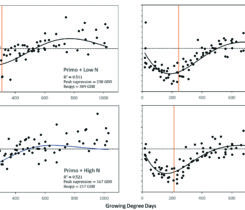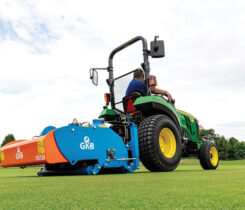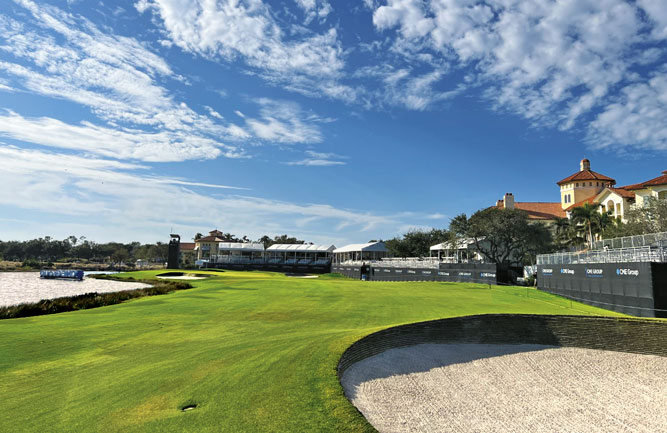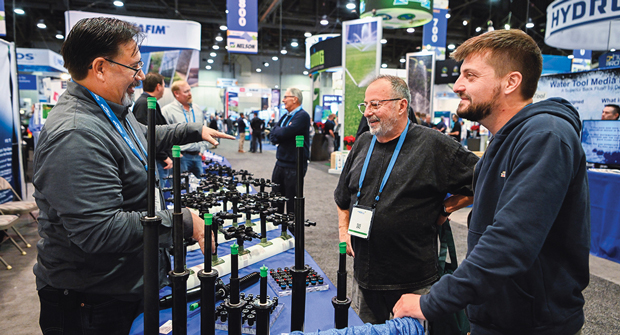How to guide PGR applications by growing degree days
At the University of Nebraska, our lab has been creating models to predict the duration and performance of plant growth regulators (PGRs) using growing degree day (GDD) models. We have more than 570 different models specific to grass species, the active ingredient, application rate and even mowing height.
We developed a web-based decision-support tool called GreenKeeper (GreenKeeperApp.com). The goal was to house and drive the various PGR-GDD models with automated weather data retrieval. Users select the PGR, and GreenKeeper tells them how it is working at their golf course.
With support from the USGA, we created a new model that guides managers with the correct partial PGR application rate when making a follow-up application before the ideal reapplication interval. The model will limit the stacking effect and intensification of growth suppression documented in previous research.
We started the experiment on a creeping bentgrass golf fairway mowed at 0.4 inch. The 10 treatments included a nontreated control for normalization and a 3-by-3 factorial of Primo (trinexapac-ethyl), Trimmit (paclobutrazol) and Anuew (prohexadione-Ca) applied weekly at either the standard rate or two different fractions of the standard rate depending on growing degree day accumulation.
We based the equation used to estimate PGR degradation on the half-life:
Replacement PGR rate (ounce/acre) = Full PGR rate – Full PGR rate × 0.5 [ Current GDD/Half-life in GDD]
The Primo, Trimmit and Anuew full rates were 7, 16 and 11 ounces per acre, respectively. The tight and long estimated half-lives for Primo, Trimmit and Anuew were 116/175 GDD, 160/240 GDD and 140/210 GDD. We collected clippings several times each week to determine if clipping yield suppression was static or intensifying over time.
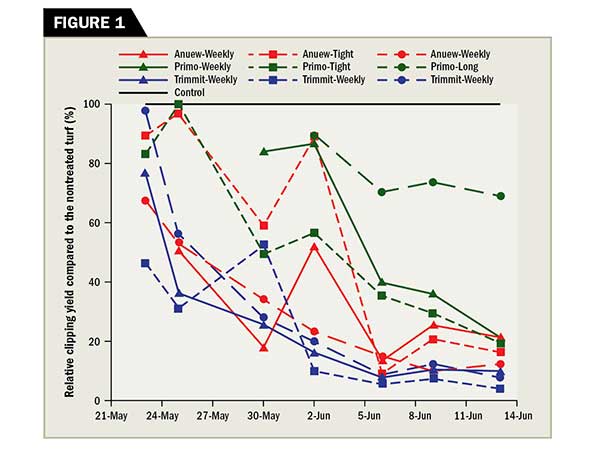
The impact of different PGR reapplication models on the relative clipping yield suppression of a creeping bentgrass fairway mowed at 0.400 inch. (Graphic: Golfdom Staff)
After four weeks, we stopped this experiment because clipping yield suppression intensified over the three applications for all treatments except for Primo with the 175 GDD half-life (Figure 1). Strong phytotoxicity (Figure 2) and greater than 80 percent clipping yield suppression for all other treatments relative to the nontreated control resulted. Future research will evaluate other degradation models (i.e., linear) and different proposed half-life coefficients. This research will help with variable rate sprayers and minimize PGR-induced collar decline.
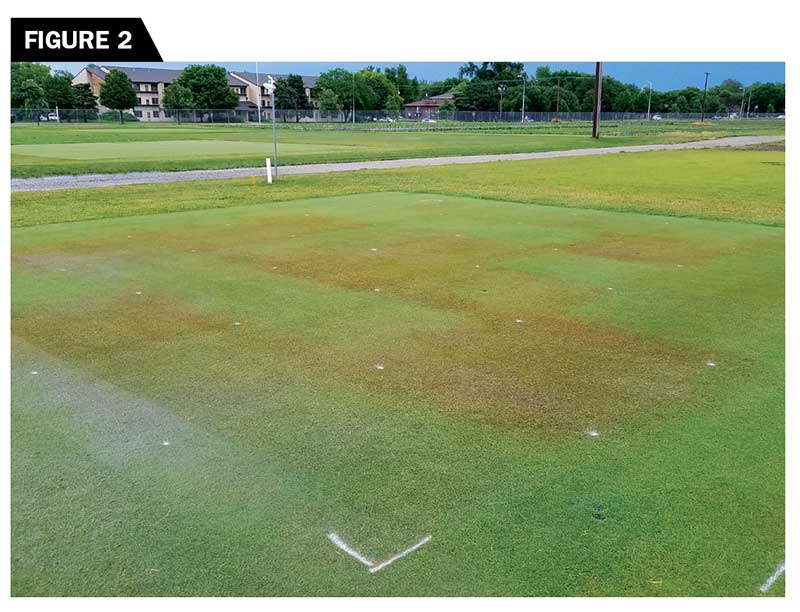
The impact of different PGR reapplication models on the turfgrass quality of a creeping bentgrass fairway mowed at 0.4 inch. (Photo by: William Kreuser, Ph.D.)
We created a refined PGR-GDD model based on the clipping yield results from the PGR study above and a DMI fungicide/PGR combination trial collected from a creeping bentgrass putting green during fall 2019. This model accounts for individual PGR application performance and generates a predicted “cumulative clipping yield suppression” value from the combination of the various PGR and DMI applications. The model uses segmented nonlinear regression with a breakpoint at 23.1 percent clipping yield suppression. It has an R2 value of 0.763.
We tested the performance of this new PGR Model on a 007 creeping bentgrass putting green during the summer of 2020. This research green was built to USGA recommendations for putting green construction and irrigated to prevent wilt.
Treatments included a factorial of four PGR treatments (nontreated, Primo at 5.5 ounces/A, Primo at 33 ounces/A, and Primo (5.5 ounces/A) + Trimmit (16 ounces/A) by two N fertilization rates (0.15 or 0.30 pound N per 1,000 feet2) and two different mowing heights (0.12 and 0.08 inch).
We applied the PGRs at 200 GDD for Primo alone or 280 GDD when Primo was mixed with Trimmit. Data were collected every two weeks from June through July. Measurements included green speed before and after clipping yield collection, turfgrass quality and color from a Holland Scientific Rapid Scan active sensor.
Turf maintained at the lower height of cut (HOC) and higher N rate had an increased clipping yield. When averaged across the entire season, the grass mowed at 0.08 inch grew 45 percent faster than grass cut at 0.12 inch. The accelerated growth rate increased nutrient removal and carbohydrate depletion during mowing. As a result, the higher N rate was required to sustain acceptable turfgrass quality at the lower height of cut.
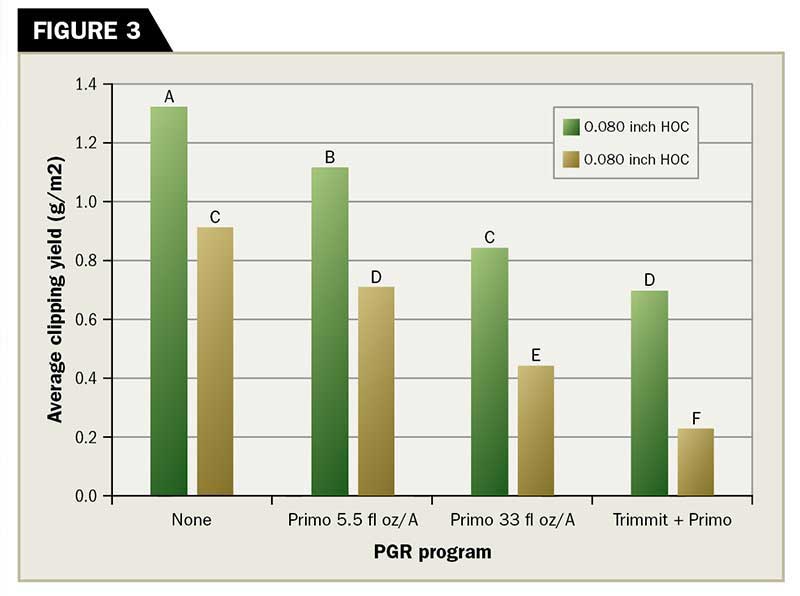
The PGR program’s influence on average clipping yield production from a creeping bentgrass putting green at 0.12-inch or 0.08-inch height of cut. (Graphic: Golfdom Staff)
The Primo treatments (one-time or six-time label rates) had the best turfgrass quality at each HOC and N treatment. There was never phytotoxicity from the high rate of Primo applied alone. Total clipping yield suppression from that high rate of Primo was more significant than the one-time rate. Still, it was less than Primo and Trimmit used together at the maximum labeled rates for bentgrass putting greens (Figure 3).
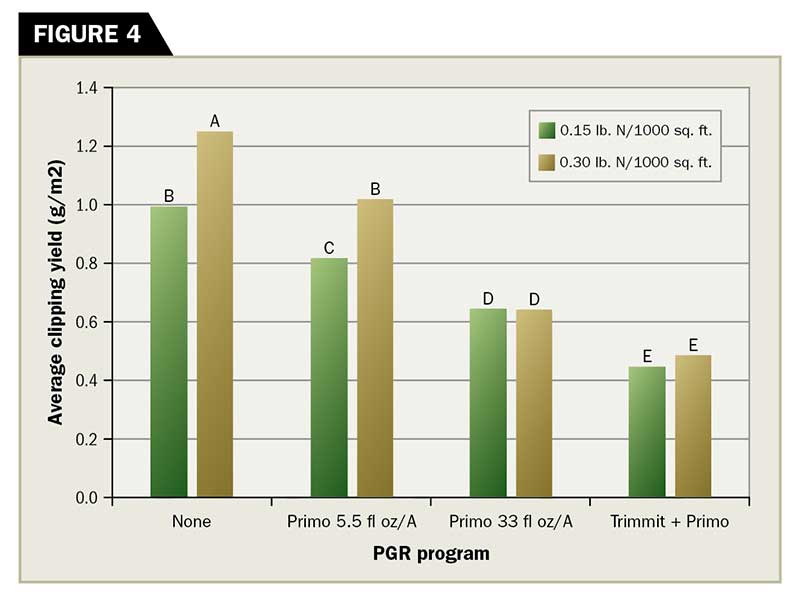
The influence of the PGR program on average clipping yield production from a creeping bentgrass putting green receiving 0.15 or 0.30 lb. N ft-2 every two weeks. (Graphic: Golfdom Staff)
Both the six-time rate of Primo and combination treatment with Trimmit prevented enhanced clipping yield from the high N rate at both HOCs (Figure 4). The one-time rate of Primo was unable to offset the clipping yield increase that resulted from the higher N application rate.
The PGR combination of Primo and Trimmit enhanced ball roll distance by 8.4 inches. The Primo treatments applied alone only enhanced ball roll distance by 3 to 4 inches — a distance that golfers would not perceive. Increasing the N rate from 0.15 to 0.30 lb. N per 1000 feet2 did not influence ball roll distance, and the lower HOC only enhanced ball roll distance by 4.8 inches.
Research takeaways:
- We tested a model to estimate the amount of PGR remaining in the plant when the PGRs were applied before their ideal reapplication interval. A half-life approach model was used to schedule the PGR application rate. The model tested resulted in an intensification of clipping yield suppression and increase phytotoxicity over time. The results indicate the models were too aggressive.
- A new PGR-GDD model accounts for the clipping yield suppression of multiple PGR and DMI fungicide applications. The model was developed from a combination of various datasets and had an R2 value of 0.763.
- In 2020, the new PGR model was used to evaluate putting green performance when PGR ingredients were mixed. Mixing Primo with Trimmit increased green speed by 8.4 inches compared to the nontreated control. This mixture combined with higher levels of nitrogen fertilizer sustained high putting green stand density and acceptable color. We are replicating this experiment in 2021.









